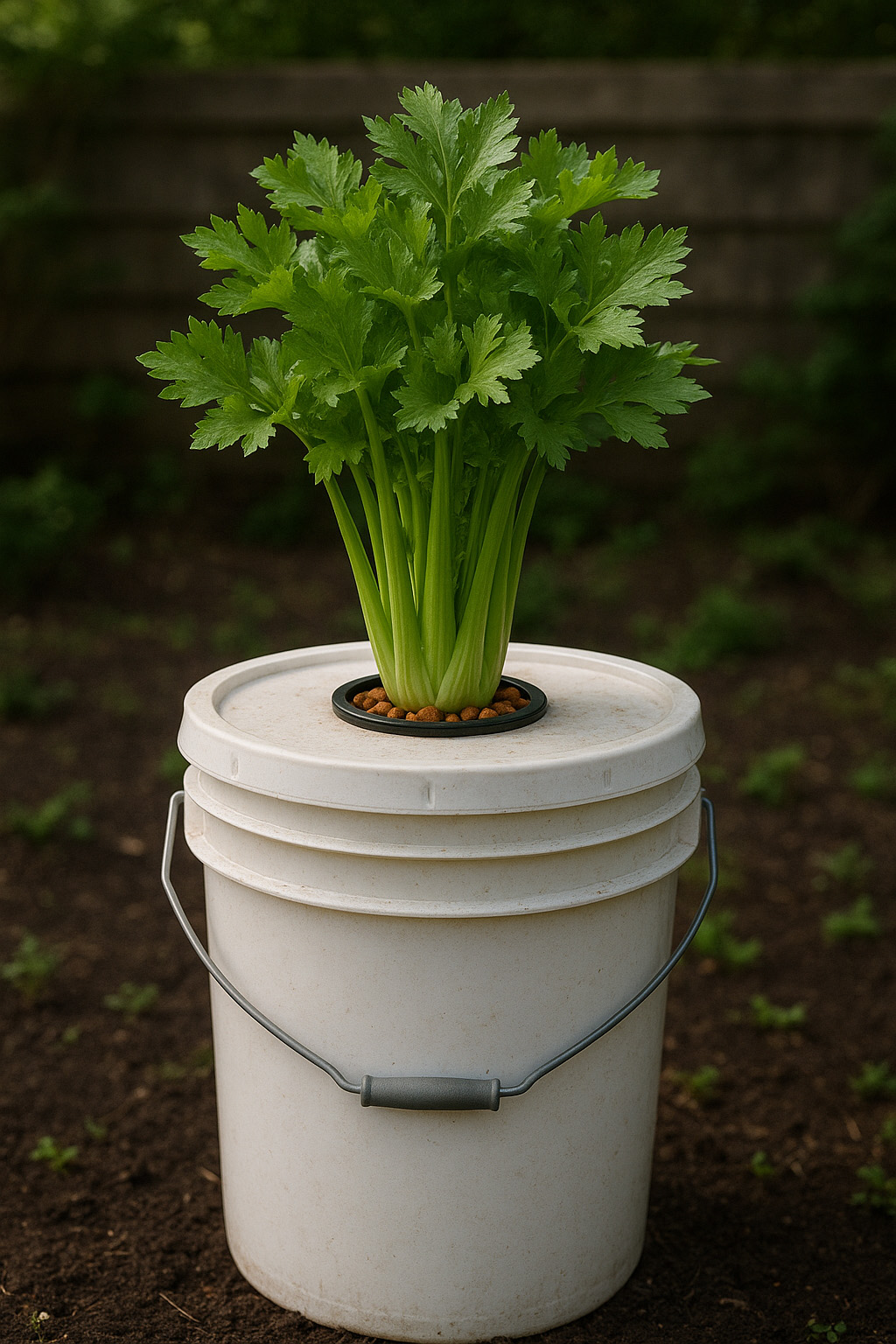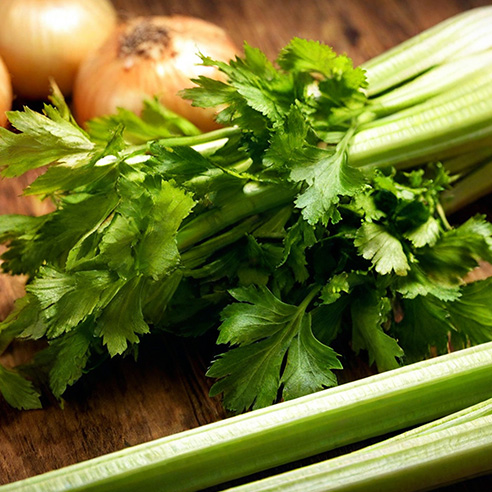Kratky Celery: Grow Fresh, Crisp Hydroponic Celery with the Kratky Method
Remember when you were a kid and you’d plant the scraps from plants to watch the grow? Celery was one of those plants and we used to take the end, put it in a glass of water until i rooted, then plant it into the garden. We grew new celery from scraps. I think that was my first hydroponic celery experiment!
The Kratly method, where you can hydroponically grow lettuce or so many other things, is pretty much the same idea, growing celery in water. It’s fun for everyone to grow celery hydroponically, especially the kids.
Hydroponic Celery is Simple with the Kratky Method
It’s simple and efficient to grow celery with the Kratky method, a passive hydroponic system ideal for gardeners of all skill levels. With no pumps, timers, or complex setups required, Kratky hydroponics offers a sustainable way to cultivate fresh, crisp celery at home. Whether you’re looking to maximize yield in small spaces or reduce water usage, the Kratky method delivers exceptional results. Learn how to grow celery hydroponically with ease, and enjoy the taste of homegrown produce year-round while supporting eco-friendly practices.


Above is Kratky hydroponic celery growing in a 5 gallon bucket in the backyard.
So what is hydroponic celery? Can you grow celery hydroponically? And why would you want to grow Kratky celery vs other methods? Celery hydroponics is not common, in fact, I would venture to guess not many people are growing celery hydroponically. Celery in hydroponics is not the norm since celery takes so long to grow. But celery hydroponically grown with the Kratky method (I call it Kratky method celery) is by far the best, freshest and crsipest I have ever eaten.
ADVERTISEMENT
Hydroponic gardening starter products on Amazon we recommend
These are the hydroponic gardening staples we recommend on Amazon. They are high-quality, will last a long time and will elevate your hydroponic garden results.
These net cups are great for hydroponic gardening and help the roots reach into the hydroponic garden solution.
These clay pebbles are great for hydroponic gardening and help the roots get air in your hydroponic garden.
These rock wools cubes are our favorite for hydroponic gardening and stimulate growth in your hydroponic garden.
These hydroponic container jar covers are our favorite for hydroponic gardening to stop algae in your hydroponic garden.
As an Amazon Associate I earn from qualifying purchases.

Kratky Celery: A Guide to Growing Celery Using Hydroponics
Growing celery using the Kratky method is an innovative way to cultivate fresh, crisp vegetables without soil or complex systems. The Kratky method, a passive form of hydroponics, is perfect for home gardeners, hobbyists, or anyone looking to grow their food sustainably. This guide will walk you through the essentials of growing celery with the Kratky method, from setup to harvest. Kratky passive hydroponics is simple too.
What Is the Kratky Method?
The Kratky method is a simple, low-maintenance hydroponic system that uses a reservoir filled with water and nutrients to grow plants. Unlike traditional hydroponic systems, it doesn’t require pumps, electricity, or moving parts, making it accessible and cost-effective. This technique is particularly well-suited for plants like celery, which thrive in a controlled, water-based environment.
Why Grow Celery with the Kratky Method?
Celery is a slow-growing vegetable that requires consistent moisture and nutrients. Traditional soil gardening can be challenging due to celery’s sensitivity to water stress and nutrient deficiencies. By growing celery hydroponically with the Kratky method, you eliminate these concerns, providing optimal conditions for healthy growth. Additional benefits include:
- Water Efficiency: The closed system minimizes water waste.
- Space-Saving: Ideal for urban gardening or small spaces.
- Pest Control: Reduced risk of soil-borne pests and diseases.
- Year-Round Growth: Grow fresh celery indoors regardless of the season.
- pH Level of Celery: The best pH level of water for optimal celery growth is typically between 6.0 and 6.5
Kratky Method Nutrients
When growing celery using the Kratky method, providing the right nutrient balance is critical, as the plant depends entirely on the nutrient solution throughout its growth cycle. Celery is a heavy feeder, particularly in nitrogen and potassium, and requires a well-balanced hydroponic nutrient mix designed for leafy greens. A typical nutrient profile should contain adequate nitrogen for leaf and stalk development, phosphorus for root establishment, and potassium for overall vigor and disease resistance. Secondary nutrients like calcium and magnesium are essential for strong cell walls and preventing common deficiencies such as leaf tip burn. Trace elements, including iron, manganese, boron, zinc, and molybdenum, must also be present in small but consistent amounts to support healthy growth.
For Kratky celery, the electrical conductivity (EC) of the solution should be maintained between 1.8–2.4 mS/cm. This range ensures sufficient nutrient availability without risking salt stress. The pH should be kept within 6.0–6.5 to optimize nutrient uptake. Since the Kratky method relies on a static solution, it’s important to start with a properly mixed nutrient reservoir, as there will be no recirculation or supplementation from outside sources other than top-ups. As the plant consumes water, the nutrient concentration will increase, so topping off with pH-balanced water—rather than adding more full-strength nutrients—is often necessary to avoid excessive EC levels.
A high-quality hydroponic nutrient blend, such as those formulated for lettuce and leafy greens, works well for celery, but growers can slightly adjust formulas to increase potassium during the later growth phase to improve stalk firmness and flavor. Using reverse osmosis (RO) or distilled water can help prevent unwanted mineral buildup in the solution, especially in long growth cycles of 90–120 days. By maintaining stable nutrient levels and pH throughout the growing period, Kratky-grown celery can produce crisp, flavorful stalks comparable to or even better than soil-grown plants.
ADVERTISEMENT
As an Amazon Associate I earn from qualifying purchases.
Setting Up Your Kratky System for Celery
Materials Needed:
- A container or reservoir (5-gallon buckets work well)
- Nutrient solution suitable for leafy greens
- Net pots and grow media (such as rock wool or clay pellets)
- Celery seeds or seedlings
- pH testing kit and adjusters
Step 1: Prepare the Reservoir
Choose a container that blocks light to prevent algae growth. Fill it with water and mix in the appropriate amount of hydroponic nutrients. The nutrient solution’s pH should be between 5.5 and 6.5 for optimal celery growth.
Step 2: Germinate Celery Seeds
Celery seeds can be slow to germinate, so start them in a warm, well-lit area. Use grow media such as rock wool cubes to hold the seeds. Once the seedlings develop a few true leaves, transfer them to the net pots.
Step 3: Set Up the Plants
Place the net pots in the holes of the reservoir lid, ensuring that the bottom of each pot just touches the nutrient solution. The roots will grow into the water, absorbing the nutrients they need.
Step 4: Monitor and Maintain
Celery requires about 10–12 weeks to mature. Check the water level periodically and add more nutrient solution as needed, ensuring the roots always have access to moisture. Avoid letting the water level rise too high, as this can limit root aeration.
Tips for Successful Kratky Celery Growth
- Lighting: Celery needs about 6–8 hours of light daily. Use grow lights if you’re growing indoors.
- Temperature: Maintain a consistent temperature between 60–75°F (16–24°C).
- Spacing: Provide adequate space between plants for airflow and light penetration.
- Nutrients: Use a nutrient solution with balanced nitrogen, phosphorus, and potassium levels to support leafy growth.
Harvesting Your Celery
Once your celery stalks are about 6–8 inches tall and firm, they’re ready to harvest. You can either harvest the entire plant or cut individual stalks, allowing the plant to continue growing. Freshly harvested Kratky celery is not only delicious but also packed with nutrients.
Why Choose Kratky Celery for Your Garden?
Hydroponic gardening with the Kratky method is an excellent way to grow celery efficiently and sustainably. Whether you’re an experienced gardener or a beginner, this method simplifies the process while yielding high-quality results. By adopting the Kratky method, you’re not only enjoying fresh, homegrown celery but also contributing to an eco-friendly approach to food production.
Explore the possibilities of Kratky hydroponics and start your journey to growing celery today. With a little effort and the right setup, you’ll enjoy crisp, flavorful celery straight from your own indoor garden.
Kratky Lettuce Frequently Asked Questions
Can celery be grown hydroponically?
Yes, celery can be grown hydroponically, and it performs well in systems like NFT (Nutrient Film Technique), deep water culture, or ebb and flow, provided the nutrient solution is kept within the ideal pH range of 6.0–6.5 and has consistent moisture and nutrient availability.
How many celery plants in a 5 gallon bucket?
In a 5-gallon bucket, you can realistically grow 1 celery plant for optimal growth.
Celery needs about 6–8 inches of space between plants, and in a confined container like a 5-gallon bucket, multiple plants will compete for water, nutrients, and root space, which can stunt growth.
Can celery be grown with the Kratky method?
Yes. Celery adapts well to the Kratky method, as it thrives in consistent moisture conditions and does not require high oxygenation early in its growth cycle.
What is the best pH for Kratky celery?
Maintain 6.0–6.5 for optimal nutrient uptake.
What temperature does Kratky celery like?
Celery prefers 60–70°F. Hotter temperatures can cause bitterness or bolting.
Do I need to change the nutrient solution?
If water quality is good and pH remains stable, you can often run the full cycle without changing the solution, but topping off with pH-adjusted nutrient water is recommended.
How long does celery take to grow in Kratky hydroponics?
Typically 90–120 days from transplant to harvest, similar to soil-grown celery, though warm, stable temperatures can shorten growth time slightly.
Does celery need to be started in soil before moving to Kratky?
No, but most growers germinate seeds in rockwool cubes, coco coir, or similar starter plugs before transferring to the Kratky container once seedlings are 2–3 inches tall.
How deep should the nutrient solution be in the container?
Fill so the bottom of the net cup is touching the nutrient solution at the start. The water level will drop naturally, creating an air gap for root oxygenation.
Can I regrow grocery store celery bottoms in Kratky?
Yes. Cut off the base of store-bought celery, place it in a net cup with hydroponic nutrients, and it will regrow leaves and stalks, though it may not produce full-sized bunches like from seed.
How much light does Kratky celery need?
At least 12–14 hours of bright light daily; if indoors, use full-spectrum LED grow lights positioned 6–12 inches above the plants.









